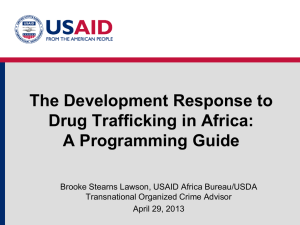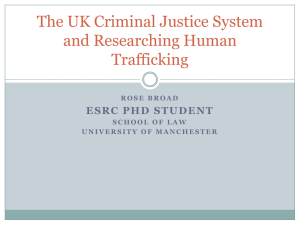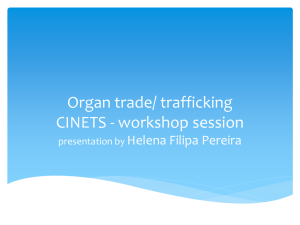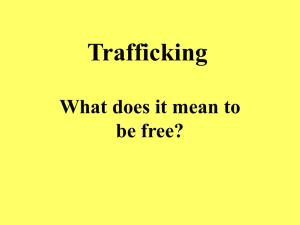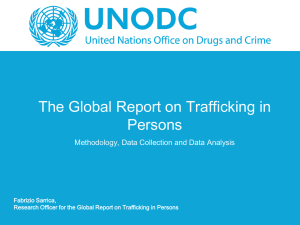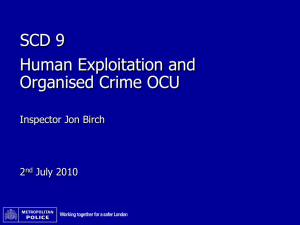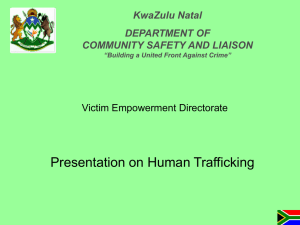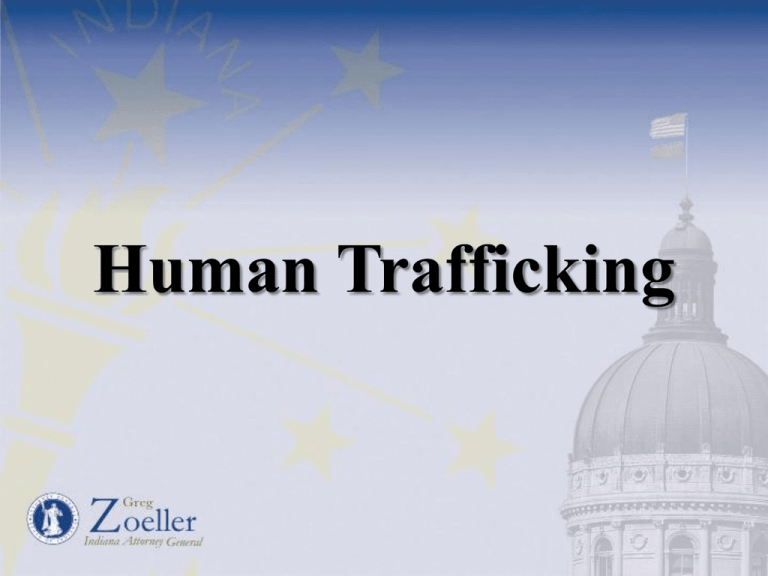
Human Trafficking
IPATH
Indiana Protection for Abused and Trafficked Humans Task Force
PREVENTION, PROTECTION, PROSECUTION
The Indiana Protection for Abused Trafficked Humans task force (IPATH)
is one of 42 task forces nationwide funded by the Department of Justice’s
Office of Victims of Crime and the Bureau of Justice Assistance to address
the issue of human trafficking.
The Goals of IPATH are to:
1) Enhance law enforcement’s ability to identify and rescue victims.
2) Provide resources and training to identify and rescue victims.
3) Ensure comprehensive services are available for victims of trafficking.
A COLLABORATIVE
CLIENT CENTERED APPROACH
LAW
ENFORCEMENT
VICTIM
SERVICES
Collaborates with agencies on
current/future investigations,
provides officer trainings, &
prevention tactics
Works with identified victims
Providing legal & social services
AWARENESS
Community organizations
partnering together to
provide outreach and
education to the
community on human
trafficking
IPATH
TRAINING
Provides trainings to
organizations that
might come into
contact with victims.
PROTOCOL
Creating and evaluating protocol
or the task force & the procedure
for handling human trafficking
situations
IPATH
Indiana Protection for Abused and Trafficked Humans Task Force
Some of the nearly 60 groups that participate in IPATH efforts are youth-related
entities or serve youth in some capacity, including:
• Indiana Department of Child Services
• Indiana Department of Education
• Prevent Child Abuse Indiana, a division of The Villages
• Children’s Bureau
• YWCA Domestic Violence Intervention and Prevention Program
• Girl Scouts
• Girls Inc.
• Outreach Inc.
• FREE International
• Indiana Coalition Against Sexual Assault
What is Human Trafficking?
Sex Trafficking: in which a commercial sex act is induced by force, fraud,
or coercion, or in which the person induced to perform such act has not
attained 18 years of age; or
Labor Trafficking: The recruitment, harboring, transportation, provision,
or obtaining of a person for labor or services, through the use of force, fraud,
or coercion for the purpose of subjection to involuntary servitude, peonage,
debt bondage, or slavery. (1)
1)
Victims of Trafficking and Violence Protection Act of 2000, Pub. L. No. 106-386 (2000), available at http://www.state.gov/documents/organization/10492.pdf.
Human Trafficking Cases
Case #1:
Three cousins, both under 18, move to the
United States to go to school. They are
promised food, housing, and enrollment at
school while living with their aunt and
uncle. However, once they arrive, they are
forced to work long hours each day after
school and on weekends, sometimes until 2
AM on school nights. They must sleep on
the floor of an apartment. Other workers,
many of whom are much older than they
are, also live in the apartment. Two cousins
still attend school, but cannot stay awake
during the day because they are often forced
to work through the night. They have no
contact with their family back home and are
told that they owe an ever increasing debt
with almost no hope of ever paying it off.
Case # 2:
A 15-year old female responds to a work ad
in a Spanish language newspaper and meets
two men at a hotel, supposedly for an
interview for a maid’s position. The men
take her to a hotel room, where she is kept
and forced to provide commercial sex
services for 48 hours. After that time, the
men leave, and she runs home. Her mother
takes her to the ER, where a concerned
physician calls the police. She is both
physically and psychologically injured, due
to the multiple rapes endured. The police
arrive at the hotel within 2 hours of the girl
leaving. Unfortunately, they are not able to
conduct a thorough investigation, because
the men had paid for the room in cash and
under false names, and the room had
already been cleaned.
A Growing Problem Worldwide
Human Trafficking is tied as the SECOND LARGEST and FASTEST growing criminal
industry in the world, just behind the drug trade.
(1)
According to the U.S. Dept. of State’s
2012 Trafficking in Persons
Report(TIP), 27 million men, women,
and children are victims of human
trafficking. (2)
161 countries identified as being affected by human
trafficking. (4)
The 2010 TIP Report stated that: (3)
– 800,000 people are trafficked
across international borders every
year.
$32 billion dollars generated annually by the human
trafficking industry. (5)
– Prevalence of trafficking
victims worldwide: 1.8 per 1,000
inhabitants
1)
2)
3)
4)
5)
Administration for Children & Families, U.S. DEPT. OF HEALTH & HUMAN SERVICES, http://www.acf.hhs.gov/trafficking/about/index.html (last visited Jan. 13, 2012).
U.S. Dept. of State Trafficking in Persons Report (2012), available at http://www.state.gov/j/tip/rls/tiprpt/2012/index.htm.
U.S. Dept. of State Trafficking in Persons Report (2010), available at http://www.state.gov/g/tip/rls/tiprpt/2010/index.htm.
UN OFFICE OF DRUGS AND CRIME, TIP REPORT: GLOBAL PATTERNS (2006) at p.58, available at http://www.unodc.org/pdf/traffickinginpersons_report_2006ver2.pdf.
INTERNATIONAL LABOR ORGANIZATION (ILO), A GLOBAL ALLIANCE AGAINST FORCED LABOR (2005) at p.55, available at
http://www.ilo.org/wcmsp5/groups/public/@ed_norm/@declaration/documents/publication/wcms_081882.pdf.
A Growing Problem Here at Home
Between 14,500 and 17,500 men, women, and children are trafficked into the United States
each year. (1)
33% of a sample group of female commercial sex workers in Chicago began in the sex trade
between the ages of 12 and 15, with 56% being 16 or younger. (2)
83% of sex trafficking victims found in the U.S. were U.S. citizens, according to one Justice
Department study. (3)
* Human Trafficking affects men, women, and children of all
ages, nationalities, education, and socio-economic statuses
1)
2)
3)
U.S. DEPT. OF STATE TRAFFICKING IN PERSONS REPORT (2010), available at http://www.state.gov/g/tip/rls/tiprpt/2010/index.htm; see also CONGRESSIONAL RESEARCH SERVICE,
TRAFFICKING IN PERSONS: U.S. POLICY AND ISSUES FOR CONGRESS (2010) at p.2, available at
http://www.unhcr.org/refworld/topic,4565c22535,4565c25f42b,4d2d96e62,0,USCRS,,.html.
SCHILLER DUCANTO & FLECK FAMILY LAW CENTER, DOMESTIC SEX TRAFFICKING OF CHICAGO W OMEN AND GIRLS (2008), available at
http://www.law.depaul.edu/centers_institutes/family_law/pdf/sex_trafficking.pdf.
This statistic is based on one study of confirmed sex trafficking incidents opened by federally funded U.S. task forces. Human Trafficking/Trafficking In Persons, Dept. of Justice,
Bureau of Justice Statistics, http://bjs.ojp.usdoj.gov/index.cfm?ty=tp&tid=40 (last visited 1/14/2012).
A Problem Involving Children
Every year 1 million children are exploited by the commercial sex trade. (1)
100,000 to 300,000 U.S. children are at risk for becoming victims of
commercial sexual trafficking each year. (2)
12-14 is the average age of entry into commercial sex in the U.S. (3)
1)
2)
3)
U.S. DEPARTMENT OF STATE, THE FACTS ABOUT CHILD SEX TOURISM (2005) at p.22 (2005), available at http://www.state.gov/documents/organization/47255.pdf.
Amanda Walker-Rodriguez and Rodney Hill, Human Sex Trafficking, FBI LAW ENFORCEMENT BULLETIN, (March, 2011), available at http://www.fbi.gov/statsservices/publications/law-enforcement-bulletin/march_2011/human_sex_trafficking.
Some research indicates that the average age of entry for U.S. girls is 12 to 14, while the average age for U.S. boys and transgender youth is 11 to 13. See Amanda WalkerRodriguez and Rodney Hill, Human Sex Trafficking, FBI LAW ENFORCEMENT BULLETIN, (March, 2011), available at http://www.fbi.gov/stats-services/publications/law-enforcementbulletin/march_2011/human_sex_trafficking. See also POLARIS PROJECT, CHILD SEX TRAFFICKING AT-A-GLANCE, (2011), available at
http://loveandlighttofreedom.org/uploads/Child_Sex_Trafficking__Polaris_Project-_Jan_2012_.pdf. See also Ernie Allen, President and CEO of the National Center for Missing and
Exploited Children, speaking to the House Victims’ Rights Caucus Human Trafficking Caucus, Cong. Rec., 111th Cong., 2nd sess., 2010. See also U.S. Children are Victims of Sex
Trafficking (April 2008), HUMANTRAFFICKING.ORG, http://www.humantrafficking.org/updates/801.
Midwest/Indiana Statistics
Investigations in US
BJA Funded Anti5,143 (2007-2012)
Trafficking Task Forces
Investigations in
Midwest
392 (2007-2012)
(1)
Investigations in
Indiana
112 (law enforcement)
96 (service providers
funded through OVC)
US Statistics- Fiscal Year 2012
(2)
26 DOJ-led taskforces
Number of Investigations in the US
over 753
ICE-HSI
894
FBI
306 pending (adults and foreign child victims)
440 (sex trafficking of children)
1) Information was obtained from the Bureau of Justice Assistance (BJA). The BJA Task Forces in the Midwestern Region were located in the states of: Illinois,
Indiana, Missouri, Wisconsin, and Minnesota.
2) U.S. Dept. of State Trafficking in Persons Report (2013), available at http://www.state.gov/j/tip/rls/tiprpt/2013/index.htm.
Origin & Destination Countries
Demonstrating that the U.S. creates demand for commercial sex
The United States is one of the most popular
destinations for human trafficking.
UN Highlights Human Trafficking, ORIGIN & DESTINATION COUNTRIES, BBC NEWS available at http://news.bbc.co.uk/2/hi/in_depth/6497799.stm.
•
•
•
•
•
Partying
Youth
Power
Money
Sexuality
• Difference between sexuality
and sexualization
• Sexualized female dolls
targeted to girls as young as
4 years old
• Push-up bra bathing suits for
8-year olds
• Average child/teen spends 6
hours and 32 minutes with
media
Information on this slide taken from: American Psychological Association, Task Force on the Sexualization of Girls. (2010).
Report of the APA Task Force on the Sexualization of Girls. Retrieved from
http://www.apa.org/pi/women/programs/girls/report-full.pdf
Our Society Encourages
Demand for Commercial Sex
• In 2009, a video was posted on Youtube of 7 and 8-year olds
dancing. They were dressed in bra tops and bootie shorts and
danced seductively. The video caused a great deal of
controversy and posed a danger of exploitation for the girls.
– Despite the risk of exploitation, these girls became so popular that they
appeared on Good Morning America.
• Miley Cyrus was the Disney star and role model for thousands
of pre-teen and teenage girls. Her most recent tour was called
“Bangerz.”
– In this tour, Cyrus dresses seductively and provocatively dances on
singer Robin Thicke, who can also be mentioned as contributing to
demand culture for his song "Blurred Lines" at the 2013 Video Music
Awards.
Who is involved in trafficking?
• The recruiter gains the victim’s trust and then sells them for
labor or to a pimp. Sometimes this is a boyfriend, a neighbor,
or even a family member.
• The trafficker is the one who controls the victims. Making
the victim fearful through abuse, threats, and lies the trafficker
gains power over his/her victim.
• The victim could be anyone.
• The consumer funds the human trafficking industry by
purchasing goods and services. Often s/he is unaware that
someone is suffering.
The Trafficker
•The trafficker will likely be
in a lucrative business
enterprise as the heart of
human trafficking is
exploiting cheap labor.
•The trafficker may be part
of a larger organized crime
ring, or may be profiting
independently.
•Most often, he/she is the
same race/ethnicity as the
victim.
• Might be someone who knew
the victim and victim’s family.
• Will likely be bilingual.
• Will likely be an older man
with younger women who
seems to be controlling,
watching their every move, and
correcting/instructing them
frequently.
The Trafficked Person
Human Trafficking reaches every culture and demographics. Regardless
of their demographics, victims are vulnerable in some way, and the
traffickers will use their particular vulnerability to exploit the victim.
Some risk factors include:
– Youth
– History of childhood abuse
– Prior involvement in child welfare system
– Poverty
– Unemployment
– Desperation
– Homes in countries torn by armed conflict, civil unrest, political upheaval,
corruption, or natural disasters
– Family backgrounds strife with violence, abuse, conflict
– Homelessness
– A need to be loved
– Immigration Status
Child Trafficking Victims Experience High Levels of
Adversity and Stress
Jim Mercy, Division of Violence Prevention, National Center for Injury Prevention and Control, Centers for Disease Control and Prevention, The
Public Health Implications of Child Sex Trafficking (PowerPoint presentation).
The Adverse Childhood Experience Studies
Jim Mercy, Division of Violence Prevention, National Center for Injury Prevention and Control, Centers for Disease Control and Prevention, The
Public Health Implications of Child Sex Trafficking (PowerPoint presentation).
The Trafficked Person
A Vulnerable Life Before Victimization *
Of boys and girls recruited into commercial sex:
•
57% had been sexually abused as children. (1)
•
49% had been physically assaulted. (1)
•
85% were victims of incest as girls, and 90% had been physically abused. (2)
•
61.5% were frequently hit, slapped, pushed, grabbed, or had objects thrown at them by a
member of their household. (3)
•
40% of the above were kicked, hit, beaten, raped, or threatened and/or attacked with a weapon
by a member of their household. (3)
•
Nearly half the participants in one study had been “molested or raped as children or teenagers.”
(4)
* These studies considered various forms commercial sex, not only sex trafficking. Due to the hidden nature of this crime, little research is
available strictly on trafficking. However, it should be noted that anyone used in commercial sex who is under 18 or is being forced or
coerced is a victim of trafficking.
1)
2)
3)
4)
Melissa Farley & Howard Barkan, Prostitution, Violence Against Women, and Posttraumatic Stress Disorder, 27 WOMEN & HEALTH 37-49 (1998), available at
http://www.prostitutionresearch.com/ProsViolPosttrauStress.html.
Hunter, S.K., Prostitution is Cruelty and Abuse to Women and Children, 1 MICH. J. GENDER & L. 1-14 (1993).
Jody Raphael & Deborah L. Shapiro, SISTERS SPEAK OUT: THE LIVES AND NEEDS OF PROSTITUTED WOMEN IN CHICAGO, CENTER FOR IMPACT RESEARCH (2002) at p.15,
available at http://www.impactresearch.org/documents/sistersspeakout.pdf.
Jennifer K. Wesely, Growing up Sexualized: Issues of Power and Violence in the Lives of Female Exotic Dancers, 8 No. 10 Violence Against Women, 1182, 1192 (October,
2002).
The Trafficked Person
• Likely has been lied to about the work they will be doing in the U.S.
• Was economically motivated to come the United States or to seek a new
job.
• Believes they have a real debt to pay and takes this very seriously.
• Has been lied to about their rights in this country and what will happen to
them if they seek help.
• Does not have any meaningful social network.
• Is extremely embarrassed about what is happening to him/her.
• May not see themselves as a victim – they may feel blame for their
situation.
• May be holding out hope that if he or she proves their worth, things will get
better
Where are trafficked persons
found?
Trafficking is found in many industries including:
•
•
•
•
•
•
•
•
The sex industry
Forced labor in agricultural or construction industries
Factories, restaurants, hotels
domestic servitude as servant, housekeeper or nanny
Health and beauty industries
As a bride
As beggars or peddlers
As a child soldier
How Are Youth Recruited?
Ways that youth are especially recruited:
•
•
•
•
•
•
•
•
(1)
Grooming process
Internet and social media
Telephone chat-lines
Clubs
On the street
Through friends
At malls
Traffickers using girls to recruit other girls at schools and
after-school programs
1) U.S. DEPARTMENT OF EDUCATION OFFICE OF SAFE AND DRUG-FREE SCHOOLS, HUMAN TRAFFICKING OF CHILDREN IN THE UNITED STATES: A
FACT SHEET FOR SCHOOLS 1 (June 26, 2007), available at http://www2.ed.gov/about/offices/list/osdfs/factsheet.pdf.
Why don’t Trafficked Persons Escape?
• They are afraid of being deported.
• They may be in danger if they try to leave.
• The traffickers have such a strong psychological and physiological
hold on them.
• They fear for the safety of their families in their home countries or
in the U.S.
• They may fear the U.S. legal system because they may not
understand the laws that protect them.
• They may not be able to support themselves on their own.
Therefore, it is our responsibility to protect
and assist people being exploited.
Human Trafficking and Technology
Social Networking
Pimps hit social networks to
recruit underage girls to engage
in commercial sex
The pimps "searched Facebook for
attractive young girls, and sent them
messages telling them that they were
pretty and asking if they would like to
make some money"
If a girl expressed interest, a gang
member would arrange to meet up. At
that point, participation stopped
being voluntary.
Messages provided by U.S. Department of
Justice. Visualization created by CNNMoney.
http://money.cnn.com/2013/02/27/technology/social/pimps-social-networks/index.html
Human Trafficking and Technology
Social Networking
The pimp may have a
collection of fake
Facebook accounts.
On one of them, for "Rain
Smith" investigators found
more than 800 messages sent
out to potential targets.
Messages provided by U.S. Department of
Justice. Visualization created by CNNMoney.
http://money.cnn.com/2013/02/27/technology/social/pimps-social-networks/index.html
Human Trafficking and Technology
Social Networking
Traffickers may pose as
any of the following on
social media:
Escort Service
Modeling Agency
Dancing Opportunity
Boyfriend
Friend
This kind of approach
works more often than
parents would like to
believe.
http://money.cnn.com/2013/02/27/technology/social/pimps-social-networks/index.html
Human Trafficking and Technology
Online Classified Ads – Craigslist.org and Backpage.com
1)
Human Trafficking and Technology
Online Classified Ads – Craigslist.org and Backpage.com
A study conducted by KLAAS KIDS Foundation
found significant increases in Backpage escort ads
leading up to the 2012 Super Bowl. (1)
An artist’s interpretation of
an advertisement on
Indianapolis Backpage
February 02nd. (2)
1)
2)
KLAAS KIDS FOUNDATION, TACKLE THE TRAFFICKER OUTREACH
KLAAS KIDS FOUNDATION, BEHIND CLOSED DOORS.
AND
MONITORING INITIATIVE (Feb. 3, 2011).
Three Elements of Trafficking
In order to be considered trafficking on both federal and state
levels, all three of these elements must be identified:
Recruiting
Harboring,
PROCESSor
Moving,
Obtaining
A person
By
Force,
MEANS
Fraud or
Coercion
For the purpose
of
Involuntary
servitude,
Debt bondage,
Slavery or
Sex Trade
END
What is Force, Fraud, & Coercion?
Force
Fraud
Coercion
Kidnapping
Promises of Valid Immigration
Debt Bondage
Torture
Documents
Threats of Harm to Victim or
Battering
Victim told to use false travel
Family
Threats with Weapons
papers
Control of Children
Sexual Abuse
Contract signed for Legitimate Work
Controlled Communication
Confinement
Promised Job differs from actuality
Photographing in Illegal
Forced use of Drugs
Promises of Money or Salary
Situations
Forced Abortions
Misrepresentation of Work Conditions
Holding ID/Travel Documents
Denial of Medical Care
Wooing into Romantic
Verbal or Psychological Abuse
Relationship
Control of Victims Money
Punishments for Misbehavior
Indiana Law: IC 35-42-3.5-1
• Trafficking:
– A person who, by force, threat of force, or fraud engages a person in:
•
•
•
•
•
Forced Labor
Involuntary Servitude
Marriage
Prostitution
Participation in Sexual Conduct
• Prosecutors don’t have to prove force when a minor under the age of
18 is being trafficked
• Restitution is available to trafficking victims
• Trafficking victims may also have a civil cause of action to recover
other damages from the trafficker
Human and Sexual Trafficking, Ind. Code § 35-42-3.5, available at
http://www.in.gov/legislative/ic/code/title35/ar42/ch3.5.pdf.
Criminal Code Felony reclassification effective July 1, 2014.
Federal Law: Trafficking Victims
Protection Act of 2000
A Comprehensive Law:
Areas of Focus:
– Prevention
• Public Awareness, Outreach and Education
– Protection
• T-Visa, Certification, Benefits and Services to Victims
– Prosecution
• Created Federal Crime of Trafficking, New Law
Enforcement Tools and Efforts
Highlights of TVPA:
•Protection provided to trafficked persons through legal
assistance and other benefits
•New crimes of trafficking and forced labor defined
•State Department reports annually on how countries are
doing in combating trafficking
–Lowest ranked countries are subject to sanctions
What is a T-Visa?
• Enables certain victims of human trafficking to live and work in the US for
four years.
– May be eligible to apply for adjustment of status to lawful
permanent resident after three years.
• Can petition to have certain family members accompany them.
• Allows access to public benefits.
• Cap of 5,000 visas annually.
– From 2002 through October, 2012, only 6,482 visas were issued.
– The reason the number of issued visas is so low is believed to be
because human trafficking victims are not coming forward.
Who is eligible for a T Visa?
• Has been a victim of a severe form of human trafficking;
• Is present in the US, American Samoa, Northern Marianas on account of
trafficking;
• Would suffer extreme hardship involving unusual and severe harm upon
removal; and
• Has complied with reasonable requests for assistance in investigation or
prosecution of acts of trafficking.
Children under 18 do not have to meet this criterion;
Law enforcement certification is not required, but is primary evidence of
assisting law enforcement.
• If inadmissible, a waiver must be sought and approved.
• Beneficiary changes under TVPA reauthorization in 2013
– Added certain family members
Law Enforcement Certification
If law enforcement certification accompanies a T Visa application,
Law Enforcement must certify that:
• The individual is a victim of a severe form of trafficking;
• The individual has complied with requests (may be ongoing) to assist
in the investigation and/or prosecution of a trafficking case;
• Children need only meet the first criterion.
• Law enforcement certification is not an absolute requirement.
Trafficked Persons and their Needs
There are four general areas of victim needs:
1.
Immediate Assistance
• Housing, food, medical, safety, security, interpretation and
legal services
2. Mental Health Assistance
• Support, Counseling
3. Income Assistance/Employment
• Cash, Living Expenses, Training
4. Legal Status and/or Other Legal Assistance
• T-Visa, Legal Services
Who Might Identify Trafficked
Persons?
Referrals about human trafficking cases can come through a
variety of means:
–
–
–
–
–
–
–
–
Other Social Service Agencies
Local Law Enforcement
Labor Issue Complaints
Federal Investigations
Local/National Hotlines
Other Government Agencies
Churches
Concerned Community Members
Identification: Social Indicators
• Potential victim is accompanied by another person who seems
controlling and/or insists on speaking for the victim
• Frequent relocation
• Numerous inconsistencies in his or her story
• Neglected healthcare needs
• Are not in control of their own money
• Lack of control of identification documents
• Individual is using false identification papers
• Restricted or scripted communication
Rescue and Restore Campaign
The National Symposium on the Health Needs of Human Trafficking Victims
Shared Hope International
Identification: Social Indicators
• Excess amount of cash
• Hotel room keys
• Chronic runaway/homeless youth
• Signs of branding (tattoo, jewelry)
• Lying about age
• Lack of knowledge of a given community or whereabouts
• Exhibits behaviors including hyper-vigilance or paranoia,
nervousness, tension, submission, etc.
Rescue and Restore Campaign
The National Symposium on the Health Needs of Human Trafficking Victims
Shared Hope International
Identification: Health Indicators
• Signs of physical abuse
– Bruises
• Poor Dental Hygiene
• Psychological Problems
– Black Eyes
– Depression
– Burns
– Anxiety
– Cuts
– PTSD
– Broken teeth
– Suicidal Ideation
– Multiple scars
– Panic Attacks
• Malnourishment
– Stockholm's Syndrome
• Evidence of trauma
– Fear/Distrust
POLARIS PROJECT AT A GLANCE FOR MEDICAL PROFESSIONALS (2010), available at http://www.cicatelli.org/titlex/downloadable/Polaris%20Project%20At-AGlance%20for%20Medical%20Professionals%20Final.pdf.
Key Questions to Keep in Mind
1.
2.
3.
Are they being forced to do
something they don’t want to do?
Is the person allowed to leave their
place of work?
Has the person been physically
and/or sexually abused?
4.
Has the person been threatened?
5.
Does the person have a passport and
other documents, or are they taken
away?
6.
Has the person been paid for his/her
work or services?
7.
How many hours does the person
work a day?
8.
What are/were the living conditions?
9.
How did the person find out about
the job?
10.
Who organized the person’s
migration?
11.
Do they have to ask permission to
eat, sleep, or go to the bathroom?
12.
Do they believe they owe money for
their travel or other expenses?
13.
Has anyone threatened their family?
14.
Where do they sleep and eat?
15.
Is there a lock on their door or
windows so they cannot get out?
If you believe someone is a victim of
Human Trafficking:
In emergency situations:
•Indianapolis Trafficked Persons Assistance Program 24-hour hotline:
1-800-928-6403
•National Human Trafficking Resource Center Hotline Number
1-888-3737-888 or send a text to BeFree (233733)
•Call 911
In non-emergency situations, you may also:
•Email Indiana Attorney General’s Office, humantraffickingtip@atg.in.gov
Youth Curriculum IPATH Offers
Human Trafficking 101:
– 45-minute informational overview of trafficking
– Discusses:
•
•
•
•
Definition of terms,
A look at who is involved,
Red flags for possible trafficking scenarios, and
Action steps for how youth can be involved in standing
up against this problem.
Youth Curriculum IPATH Offers
Empowering Youth to End Sexual Exploitation:
– Four 45-minute sessions
– Looks at cultural myths, trends, and influences that feed
into sex trafficking and sexual exploitation
– Engages youth in activities, critical thinking, and learning
to become change agents
Youth Curriculum IPATH Offers
My Life, My Choice:
– 10-session course for adolescent females
– Geared toward at risk or former victims of trafficking
– Covers topics such as reducing risks of exploitation, developing
self-esteem, and sexual health
What Can You Do?
• Become a part of IPATH
• Invite us to train your agency staff
• Invite us to educate your students
For more information, please contact the Attorney General’s
Office:
humantraffickinginfo@atg.in.gov




